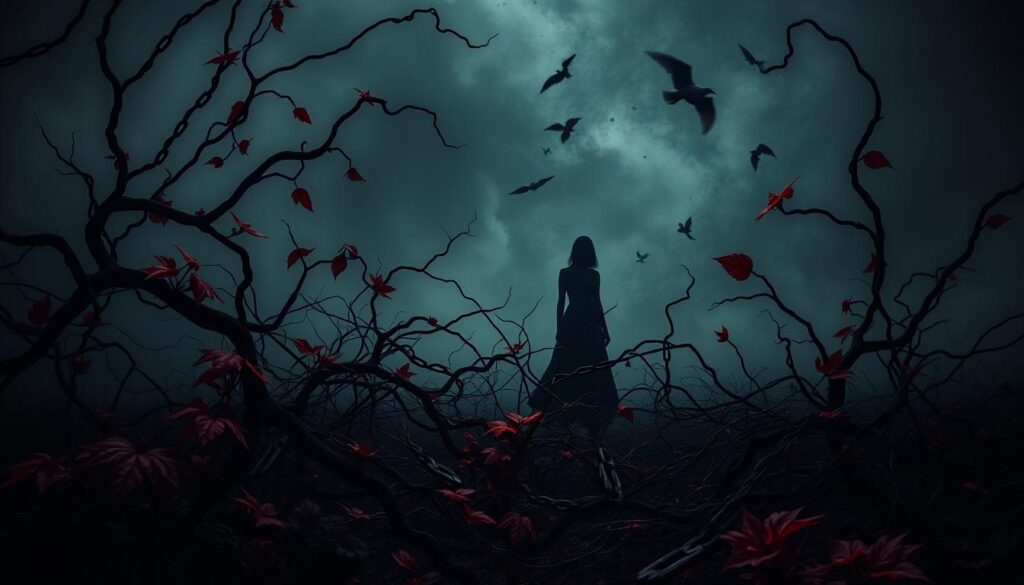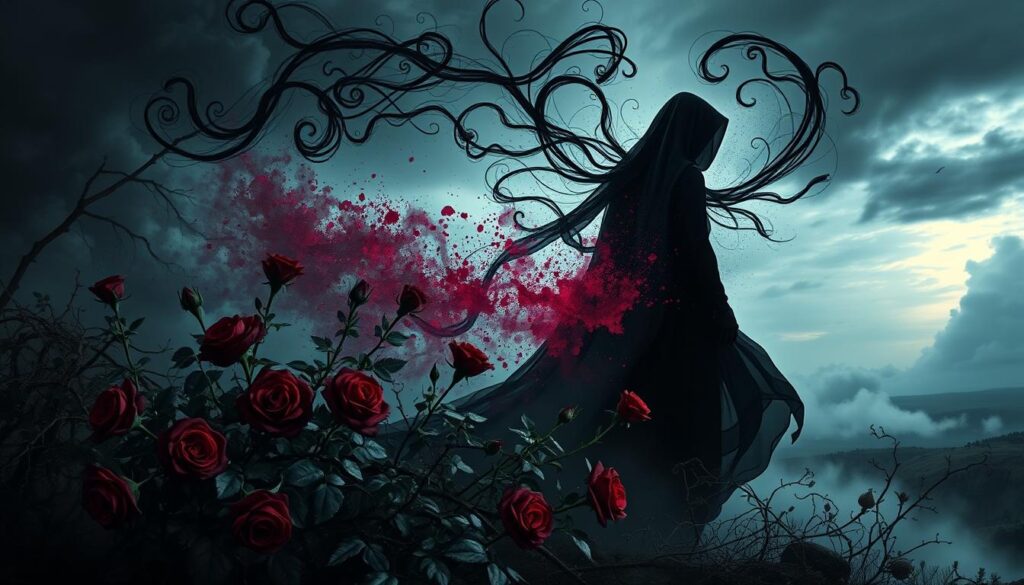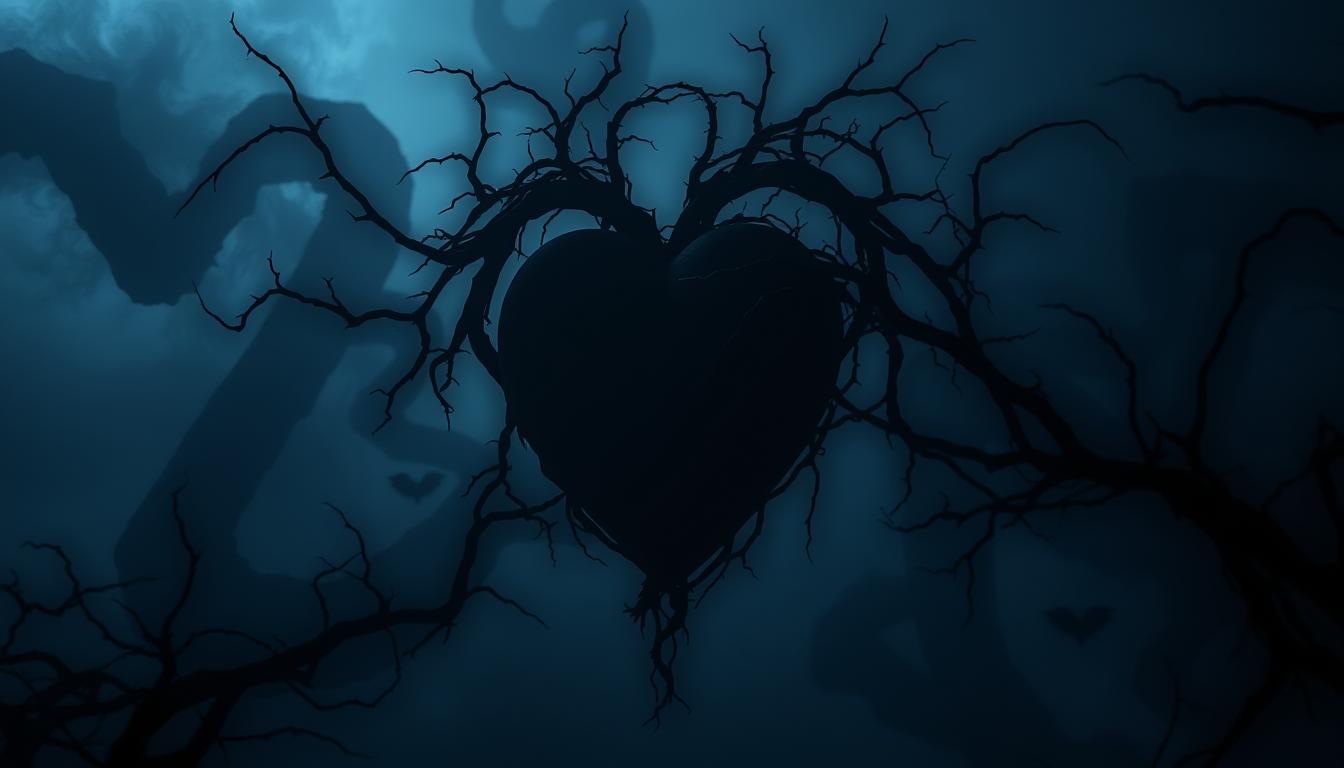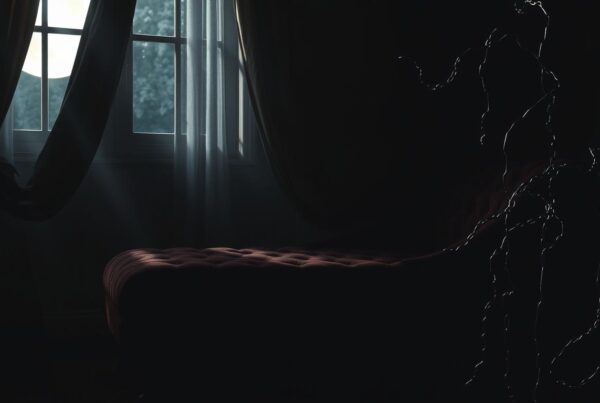Psychological thrillers and dark romance novels often share a thin line. They explore the deep passions that can make love and obsession hard to tell apart. These stories draw readers into worlds where toxic relationships and obsessive love are key, making us question what healthy love looks like.
Dark romance novels dive into the human mind, showing the complex feelings that push characters to extreme actions. They mix romance with suspense, keeping readers hooked with their gripping stories and complex characters.
Let’s dive into why these dark stories captivate us. We’ll look at the psychological sides that make them both exciting and creepy. Join us as we explore the world of psychological dark romance, where love and madness mix in surprising ways.
Understanding Psychological Dark Romance: A Genre Overview
The dark romance genre mixes love stories with psychological elements. It creates intense tales that explore human nature’s shadows. These stories dive into complex relationships, often crossing boundaries and challenging what we think of love.
Books in this genre show characters fighting inner demons and past traumas. They also deal with obsessive desires. The genre’s charm is in its emotionally charged stories that make us question love and obsession.
Taboo themes are common in these tales, adding a forbidden attraction. This keeps readers excited. Authors tackle topics like age gaps and power imbalances, making the stories thrilling.
At the heart of psychological dark romance are intense relationships. Characters get caught up in passionate, all-consuming bonds. These relationships are complex, with power struggles and emotional turmoil.
The genre is growing, attracting readers who want to explore love’s darker sides. Dark romance combines romance with deep psychology. It offers a unique reading experience that appeals to those who love intense, emotionally charged stories.
The Allure of Darkness: Why Readers Are Drawn to Psychological Dark Romance
Psychological dark romance captures readers with its deep emotions and forbidden themes. It explores desires and fears in a way that’s different from regular love stories.
Exploring the Forbidden: Taboo Themes in Dark Romance
Taboo romance lets readers explore new emotional areas. These stories often show relationships that go against the norm. It’s exciting to see characters break rules without facing real-world problems.
The Thrill of Danger: Adrenaline and Emotional Intensity
Dark romance novels are full of intense emotions. Readers feel a rush of excitement as characters face danger and passion. This keeps them hooked and eager to know what happens next.
Catharsis Through Fiction: Processing Complex Emotions
Fictional catharsis is key in dark romance’s appeal. These stories let readers deal with their own feelings. By living through characters’ ups and downs, readers learn about themselves and find emotional relief.
Reader psychology in dark romance is complex. Its popularity comes from offering a mix of escape, emotional depth, and mystery. As readers dive into these stories, they’re pulled into a world where love and darkness blend in intriguing ways.
Characteristics of Psychological Dark Romance Protagonists
Psychological dark romance draws us in with its complex characters. These heroes and villains are not always clear-cut. They live in a world where right and wrong are not always clear.
Anti-heroes are at the heart of this genre. They are flawed and sometimes dangerous. But their weaknesses make them hard to resist.
These characters make us think about what is right and wrong. They challenge our beliefs and values.
Character growth is key in psychological dark romance. We see these characters change as the story goes on. Their journey keeps us guessing and excited.
The appeal of these characters is their complexity. They are not just good or bad. This makes the story emotionally rich and engaging.
The Psychology Behind Obsessive Love in Dark Romance
Dark romance explores intense, obsessive love. It looks into the complex feelings that push characters to extreme actions. By studying psychology, we can understand why these stories are so captivating.
Understanding Attachment Styles in Fictional Relationships
Attachment theory is key in dark romance. Characters often show anxious or avoidant attachment. These styles affect how they connect and form bonds.
Anxious characters cling tightly to their partners. Avoidant ones find it hard to open up.

The Role of Trauma in Shaping Character Motivations
Trauma psychology shapes character motivations in dark romance. Past traumas influence their actions and choices. A character’s history may lead them to seek control or safety in unhealthy ways.
This creates complex, engaging relationships. It draws readers into the story.
Exploring the Concept of Limerence in Dark Romance
Limerence, intense infatuation, drives dark romance plots. Characters feel overwhelming desire and obsession. This state mixes love and madness.
Authors use limerence to craft thrilling stories. The characters’ deep passion drives the plot and tension.
Blurring the Lines: When Love Becomes Dangerous
Psychological dark romance novels show a thin line between love and obsession. They delve into the darker side of love, revealing how strong feelings can turn toxic. Characters cross lines, use mind games, and get stuck in codependent traps.
In these stories, love turns into a harmful force. Characters start with the best of intentions but harm grows. Emotional abuse signs appear as the tale unfolds. Instead of trust, possessiveness, jealousy, and control take over.
Dark romance novels are warnings about keeping healthy boundaries. They make readers think about their own relationships. By tackling these themes, authors help us see how emotional abuse can sneak up. This genre teaches us to spot danger signs and seek help if needed.
The Thin Line Between Love and Madness in Psychological Dark Romance
Psychological dark romance is a tightrope between love and obsession. Authors mix romance with thriller elements to grab readers. They dive deep into human feelings, pushing characters to their limits.
This genre mixes love and obsession, making it hard to tell the difference. Characters often question their feelings, making it tough for readers too. This mystery keeps readers hooked and guessing.
Mental health is key in these stories. Authors show characters with real flaws and struggles. They handle mental health with care, letting readers explore feelings safely.
The thriller parts add suspense and uncertainty. Unreliable narrators and twists keep readers guessing. This mix of romance and thriller makes the genre very engaging.
Toxic Relationships in Fiction: A Reflection of Real-World Issues
Psychological dark romance often shows real-life relationship problems. These stories dive into complex relationships, highlighting toxic patterns. They help readers understand harmful behaviors in a safe way.
Recognizing Red Flags in Fictional and Real Relationships
Dark romance novels often point out relationship red flags. Characters might show controlling behavior, jealousy, or emotional manipulation. These signs teach readers to spot similar issues in their own lives.
The Impact of Childhood Experiences on Adult Relationships
Many dark romance heroes face the effects of childhood trauma. This shows how early experiences shape adult relationships. By showing characters deal with their past, authors teach us about the lasting impact of childhood.
Breaking the Cycle: Character Growth and Redemption Arcs
Character redemption is a key theme in psychological dark romance. Characters face their flaws and past mistakes, growing. This shows readers that change is possible, even in tough times.
The Role of Power Dynamics in Psychological Dark Romance
Power imbalances are key in psychological dark romance novels. These stories delve into the strong feelings from dominance and submission. Authors use these dynamics to craft stories that keep readers hooked.
In many dark romance tales, one person controls the other. This control can be subtle or very direct. The person in control might use tricks like gaslighting or emotional blackmail.
Consent issues often come up because of these power imbalances. Readers feel complex emotions as they see characters deal with unclear consent. The mix of desire and fear makes for a thrilling yet uneasy read.
Authors of dark romance must be careful with these power imbalances. The genre lets them explore forbidden topics, but they must think about the real world. They might add warnings or show characters learning to balance the dark sides.
At the heart of psychological dark romance are real relationship challenges, but in a more extreme way. By tackling these issues, authors make readers think about love, control, and personal limits.
Exploring the Gray Areas of Consent in Dark Romance Narratives
Consent is key in dark romance stories. Writers walk a thin line in these tales. They delve into complex relationships and power struggles. Dubious consent often pops up, making readers think about ethics.
Dark romance authors aim to show intense, risky love stories. They must show consent’s importance. This is a tricky task, needing both skill and care to avoid showing bad behavior as good.
Readers have a role too. They should think critically about these stories. It’s important to know the difference between what’s real and what’s fiction. This helps spark talks about real-life relationships and power.
Authors use special techniques to talk about consent without saying it’s okay. They might use tricky narrators or change views to show consent’s gray areas. This makes readers think more about the characters’ reasons and actions. It leads to deeper talks about the story’s ethical issues.
In the end, dark romance stories mirror our society’s battles with power, desire, and boundaries. Writers and readers both help start important talks about consent and relationships in our world.
The Art of Building Tension: Crafting Suspense in Psychological Dark Romance
Making suspense in psychological dark romance is all about mastering tension. Writers use pacing to keep readers on edge. They mix romance and thriller perfectly, keeping the story exciting from start to end.
Pacing Techniques for Maximum Emotional Impact
Great authors use pacing to make emotions stronger. They slow down for love scenes and speed up for danger. This keeps readers guessing and caring about the characters.
Using Unreliable Narrators to Heighten Uncertainty
An unreliable narrator makes the story more complex. This makes readers doubt what’s real, adding to the romance’s psychological side. It makes readers feel uneasy, just like the characters.
Balancing Romance and Psychological Thriller Elements
Genre blending is crucial in psychological dark romance. Authors must balance love scenes with thrilling moments. This keeps readers hooked, never knowing what’s next.
By mastering these elements, writers make stories that stay with readers. The mix of love and danger, truth and lies, is what makes this genre so captivating.
Ethical Considerations in Writing and Reading Dark Romance
Writing and reading psychological dark romance raises big questions about literary ethics. Authors must find a balance between their creativity and their duty to readers. This genre dives into deep themes that mix love and obsession.
Many writers include content warnings to warn readers about possible triggers. This shows respect for readers’ experiences and keeps the artistic vision alive. Readers also have a big role by being aware of the difference between fiction and real life.
Dark romance offers a safe place to explore deep emotions and situations. But, it’s key to remember the line between fantasy and reality. Healthy reader responsibility means thinking critically about the story, not seeing it as a guide for real life.
Writers and readers both help shape the ethics of this genre. Talking openly about literary ethics can lead to more thoughtful stories in dark romance. By dealing with these issues, the genre can grow in important ways.
The Healing Power of Dark Romance: Catharsis and Emotional Release
Dark romance novels are more than just exciting stories. They offer a safe space for emotional healing. Readers can explore deep feelings and experiences in a controlled way.

These stories deal with tough themes. This helps readers process their own trauma. Seeing characters face challenges can help readers understand their own feelings better.
Dark romance novels show characters overcoming hard times. This can inspire readers to face their own challenges. It’s a powerful way to grow and heal.
These stories make readers feel deeply. They can experience a range of emotions in a safe setting. This journey can bring relief and a new view on life.
Symbolism and Metaphor in Psychological Dark Romance
Writers of psychological dark romance use special tools to make their stories deep and complex. These tools add layers of meaning. Symbolism and metaphor are key in this genre. They help authors express difficult ideas about love and obsession.
Authors often use psychological symbolism to show characters’ inner struggles. A locked door might represent emotional barriers. A storm could symbolize brewing conflict. These images speak to readers on a subconscious level. They make the story’s themes more powerful and memorable.
Metaphorical storytelling is another important technique. Writers might compare a toxic relationship to a slowly spreading poison. This helps readers understand the gradual, harmful nature of unhealthy love. By using familiar concepts, authors make complex psychological ideas easier to grasp.
Subtext analysis is crucial for fully appreciating these stories. Readers must look beyond surface-level events to uncover hidden meanings. A character’s actions might say one thing, while their true feelings lie beneath. This depth keeps readers engaged and encourages them to think critically about the story’s themes.



